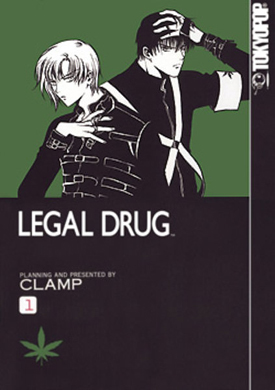 Legal Drug is a series by CLAMP, with story by Ageha Ohkawa, illustrated by Tsubaki Nekoi, that, sadly to my mind, was dropped in 2003 when the magazine in which it was being serialized ceased publication. The first three volumes, however, are worth looking at.
Legal Drug is a series by CLAMP, with story by Ageha Ohkawa, illustrated by Tsubaki Nekoi, that, sadly to my mind, was dropped in 2003 when the magazine in which it was being serialized ceased publication. The first three volumes, however, are worth looking at.
The story opens with Kazahaya Kudo wandering the streets in a snowstorm. He realizes he is freezing to death, but even though he’s determined not to die, the elements are about to have their way when he is rescued by a gigantic young man, Rikuo Himura, and taken to the Green Drug Pharmacy. The owner, Kakei, offers him a place to stay in return for working in the store. There is a catch: he has to share a room with Rikuo, and the two don’t get along very well at all. However, there is hope: Kakei periodically has extra jobs for extra pay, and Kazuhaya figures if he can save up enough, he can move into his own place. There are a couple of wrinkles here, though: he usually has to share the jobs with Rikuo, and they are always strange. It seems that Kakei is somehow aware that Kazahaya has a special gift: merely by touching an object or person, he can read their memories. And it happens that Rikuo also has a special gift — he can break things without touching them. Locks, for example. In fact, it seems the four men — there is a fourth man who seems constantly to be underfoot, Saiga, who is even larger than Rikuo, always wears dark glasses, and doesn’t seem to do much but take naps — all have special abilities.
Given that set-up, it shouldn’t come as any surprise that the story is episodic, although there is a longer arc that threads its way through the various adventures: there is a woman in Rikuo’s past whom he is trying to find. She may have been murdered, but he doesn’t believe she is dead.
The drawing is more or less shoujo standard, with a definite CLAMP cast to it — that is to say, body types are slender, with long legs and arms, features are somewhat androgynous, page layouts are fluid and intuitive. The style is loose, somewhat spare, and more than ordinarily appealing.
The relationships, as is usual in shoujo manga (which, in case you’d forgotten, is “manga for girls”), are what drives this. CLAMP is notorious for playing with boys’ love elements in their stories and not delivering, and this looks like a prime example. The relationship between Kakei and Saiga becomes obvious fairly early on, but the — hmm, call it “titillation” — is in the interaction between Kazahaya and Rikuo. They fight like the proverbial cats and dogs, but somehow Rikuo always winds up rescuing Kazahaya, and when he does, there’s always an embrace involved: no over-the-shoulder carries for Rikuo — it’s all princess style, all the way.
It’s an engaging enough series that it’s worth investigating, and there is news that CLAMP has resumed work on it. All three volumes were reissued in Japan in new editions, and a new volume was serialized in Young Ace as Drug and Drop. Dark Horse Comics picked up the North American publishing rights as of 2014, issuing an omnibus edition in 2014 with following up with Drug and Drop in 2015.
(Tokyopop, 2004-2005)
